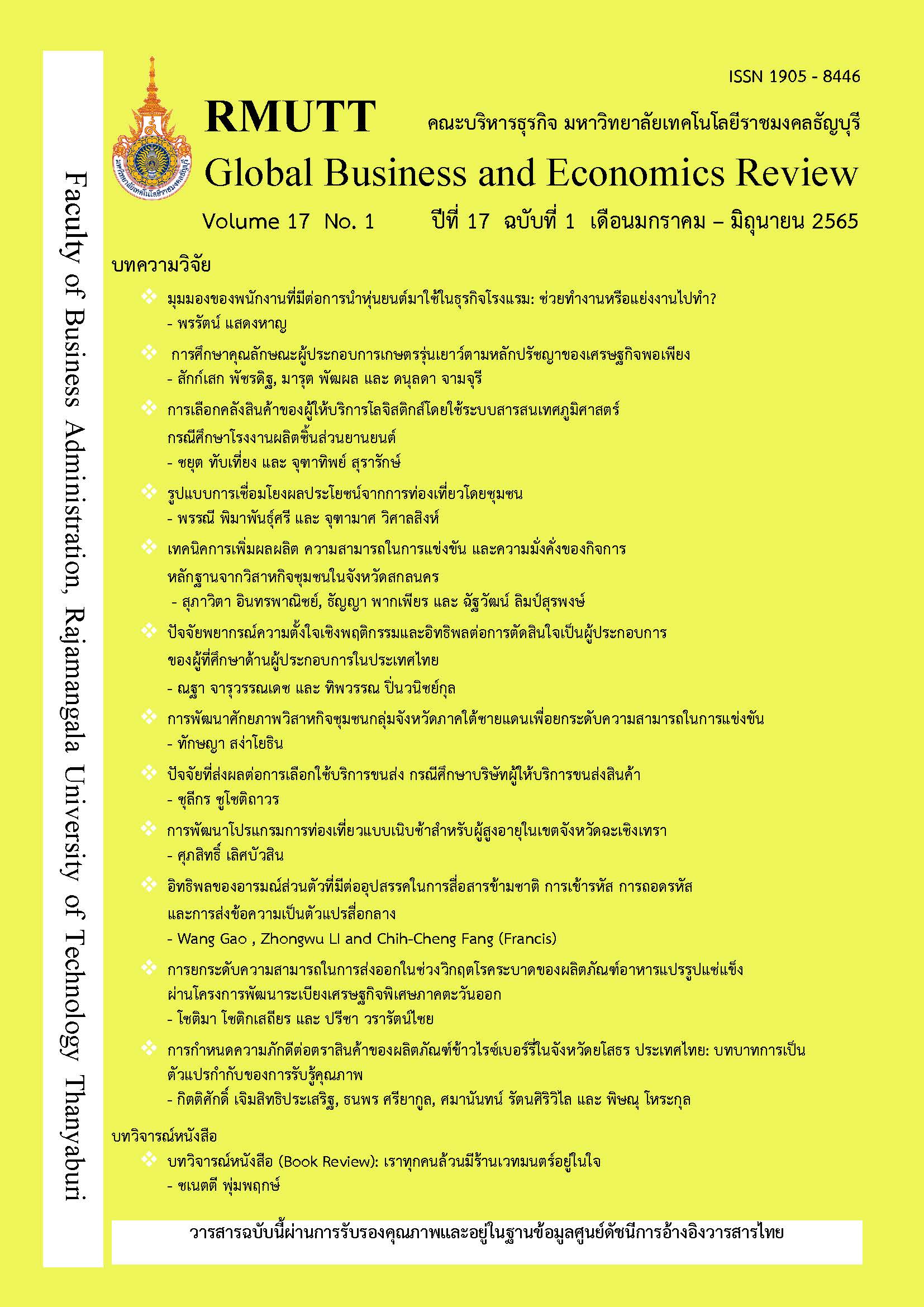POTENTIAL DEVELOPMENT FOR COMPETITIVENESS ENHANCEMENT OF COMMUNITY ENTERPRISES IN THAILAND’S SOUTHERN BORDER PROVINCES
Keywords:
Community Enterprises, Southern Border Provinces, Potential Development, CompetitivenessAbstract
The objective of this research were to analyze the problems of community enterprises and propose the guidelines for the potential development for competitiveness enhancement of community enterprises in Thailand. This was the qualitative research method using the in-depth interview with the entrepreneurs of community enterprises and the Outside-in. The study is in the southern borderal provinces of Thailand. The research results revealed that the operations of Community Enterprises in Thailand’s Southern Border Provinces showed the problems of labor shortage in manufacturing process and manufacturing technology, the lack of digital marketing knowledge and product development, and also the lack of channel of distribution. In term of finance and accounting, it did not have the appropriate base costing system, and accessing the proper funding sources, the lack of management knowledge, and attitude adjustment of members for accepting the change, lack of participation of networks and problem solving by increasing competition advantage. In term of production, it should give knowledge and necessary skills for development, promoting the leadership to members. In term of demand, it should produce goods towards the customer needs, building brand salience. In term of related industries, cooperating with building of business ecosystems. In term of strategies, organization, and competition, it should make the highlight to the online marketing and build the innovative communication throughout the platform, storytelling through the identity and the local wisdom, building creative economy within the community, and the government sector should support all useful areas and also develop any possible advantages. Moreover, the Outside-In approach was used to build the professionalism and sustainability within the community enterprises.
References
Allio, R. T., & Fahey, L. (2012). Joan magretta: what executive can learn from revisiting Michael Porter. Strategy & Leadership, 40(2), 5-10.
Astara, W. W., Budiartha, N. P., & Wesna, A. S. (2020). Legal politic of tourism village management based on local wisdom value of Pancalila’s legal ideals. International Journal of Entrepreneurship, 24(5). Retriveved from https://www.abacademies.org/articles/legal-politic-of-tourism-village-management-based-on-local-wisdom-value-of-pancasilas-legal-ideals-9853.html
Banalieva, E. R., Eddleston, K. A., & Zellweger, T. M. (2015). When do family firms have an advantage in transitioning economies? Toward a dynamic institution-based view. Strategic Management Journal, 36, 1358-1377.
Barrett, R. (2010). The importance of values in builging a high - performance culture. Retrieved from https://www.valuescentre.com/wp-content/uploads/PDF_ Resources/Additional_Articles/Article_Importance_of_Values.pdf
Batarliene, N., Ciziuniene, K., Vaiciute, K., Sapalaite, I., & Jarasuniene, A. (2017). The impact of human resource management on the competitiveness of transport companies. Procedia Engineering, 187, 110-116.
Carmeli, A., Zivan, I., Gomes, E., & Markman, G.D. (2017). Underlining micro socio-psychological mechanisms of buyer-supplier relationships: Implications for inter-organizational learning agility. Human Resource Management Review, 31(3). https://doi.org/10.1016/j.hrmr.2016.12.002
Creech, H., Paas, L., Gabriel, G. H., Voora, V., Hybsier, C., & Marquard, H. (2014). Small-scale social-environmental enterprises in the green economy: Supporting grassroots innovation. Development in Practice, 24(3), 366-378.
Doligalski, T., Zaborek, P., & Romanczuk, S. S. (2015). Vaalue proposition and firm performance: segmentation of polish online companies. International Journal of Business Performance Management, 27(1), 66-82.
Holttinen, H. (2014). Contextualizing value propositions: examining how consumers experience value propositions in their practices. Australasian Marketing Journal, 22(2), 103-110.
Koenigsfed, N. J. (2018). Role of these two factors can help managers in governmental organizations to pay more attention to the leadership styles applied in these organizations, organizational evolution – how digital disruption enforces organizational Agility. IFAC – Papers Online, 51(30), 486-491.
Mohiuddin, K. G. B., Gordon, R., Magee, C., & Lee, J. K. (2016). A conceptual framework of call for social marketing. Journal of Social Marketing, 6(2), 121-143.
National Strategic Plan Committee. (2018). The 20-year national strategy from 2017 – 2036. Retrieved from https://www.thaitribune.org/ contents/ detail/ 302?content_id=29691&rand=1506659875. (In Thai)
Porter, M. E. (1998). On competition. Boss Ton: Harvard Business School.
Pourzakarya, M., & Bahramjerdi, S. F. N. (2019). Towards developing a cultural and creative quarter: Culture-led regeneration of the historical district of Rasht Great Bazaar, Iran. Land Use Policy, 89, 1-12. https://doi.org/10.1016/j.landusepol.2019.104218
Shah, A. M. (2012). Business strategies in the emerging markets. Journal of Asia – Pacific Business, 13(1), 4-15.
Soleimanof, S., Rutherford, M. W., & Webb, J. R. (2018). The intersection of family firms and institutional contexts: A review and agenda for future research. Family Business Review, 31(1), 32-53.
Zhou, J., Bi, G., Liu, H., Fang, Y., & Hua, Z. (2018). Understanding employee competence, operational IS alignment, and organizational agility – An ambidexterity perspective. Information & Management, 55(6), 695-708.
Downloads
Published
How to Cite
Issue
Section
License
Copyright (c) 2022 ทักษญา สง่าโยธิน

This work is licensed under a Creative Commons Attribution-NonCommercial-NoDerivatives 4.0 International License.
The articles published in this journal are the intellectual property of their respective authors.
The views and opinions expressed in each article are solely those of the individual authors and do not reflect the positions of Rajamangala University of Technology Thanyaburi or any of its faculty members. All components and content of each article are the sole responsibility of the respective authors. In the event of any errors, the authors shall bear full responsibility for their own work.








